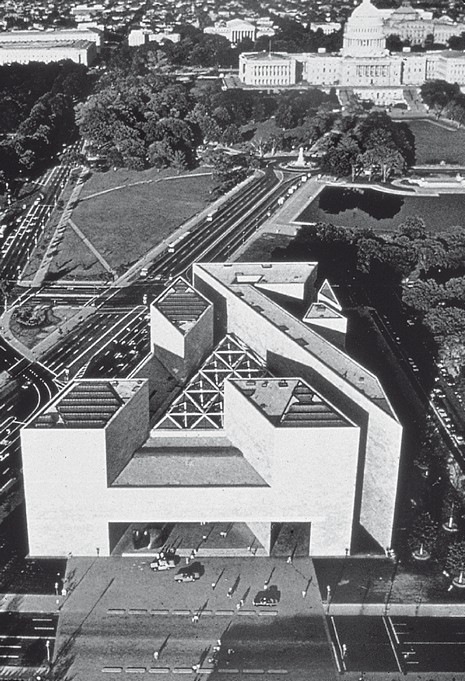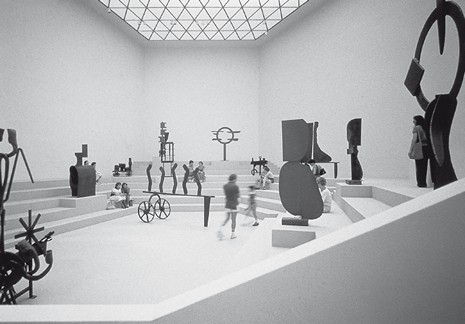Description
The extension of the neo-classicist building designed by John Russell Pope and opened in 1941 as the National Gallery was significantly determined by the trapezoid form of the site provided for it (an extension had been intended from the outset) separated from the main building by a street running along its narrow eastern side. I.M. Pei developed a modular triangular structure out of the asymmetric trapezium and the plan of taking up and continuing the longitudinal axis of the old building’s double axis. This modular structure determines the building in terms of leitmotif and detail. Thus the entire complex is organized as a large isosceles triangle and a somewhat smaller right-angled triangle whose longer side is aligned with the main building. This division of the plot of land into two complementary triangles reflects the different uses to which they are put. While the smaller, eight-storey building segment accommodates the administrative functions and a study centre for visual arts, the larger one serves as an exhibition wing. A 16,000 square metre atrium, also triangular, roofed over with a glazed lattice of tetrahedrons, not only links the two parts, but also serves as access and orientation space for the entire museum. Because its alignment cuts the ground plan of the striking corner towers out of the complex as a whole, the dimensions of this inner courtyard also determine the vertical structure and in so doing, the sharp-edged external form of this pink marble-clad architecture, which presents a self-assured counterpoint to the old building, with which it is connected by an underground passageway.
The towers in the corners of the large triangle house the majority of the exhibition rooms. Those on the uppermost floors and the galleries in the wing between are lit by natural light from above. The implementation of a largely six-cornered ground plan for the exhibition rooms – developed through the consistent use of the modular structure – means that not only are sharp angles unsuitable for exhibition purposes avoided, but also that surprising spatial experiences and a variety of spatial connections are created. Again and again these lead back to the light-flooded 18-metre high atrium spanned by catwalks and footbridges. It is not least this atrium’s communicative qualities that bring to expression a significant aspect of today’s museum design.
Baumeister 4/1976, pp. 306-307 • Architectural Record 8/1978, pp. 79-92 (William Marlin) • werk.archithese 25-26/1979, pp. 33-36 (Werner Oechslin) • Progressive Architecture 10/1978, pp. 49-59 and 8/1983, pp. 76-79 • The Architectural Review 983/1979, pp. 22-31 (Colin Amery) • Casabella 43/1979, pp. 34-37 (Nico Calavita) • Techniques et Architecture 326/1979, pp. 56-57 • Bruno Suner, Ieoh Ming Pei, Basel/Boston/Berlin, 1989, pp. 92-103 • Alexander Tzonis/Liane Lefaivre/Richard Diamond, Architecture in North America since 1960, London, 1995, pp. 174-175 • Josep M. Montaner/Jordi Oliveras, Museums for a New Century, Barcelona, 1995, pp. 54-57 • Carter Wiseman, I.M.Pei. A Profile in American Architecture, 2nd ed. New York, 2001, pp. 155-183
Drawings
Site plan
Ground floor
Second floor (atrium)
Third floor (mezzanine)
Fifth floor (main gallery)
Sixth floor
Seventh floor
Photos

Aerial view with the capitol in the background shows how the structure of the building is integrated into the geometry of the city’s layout

One of the hexagonal exhibition rooms on the top floor
Originally published in: Paul von Naredi-Rainer, Museum Buildings: A Design Manual, Birkhäuser, 2004.